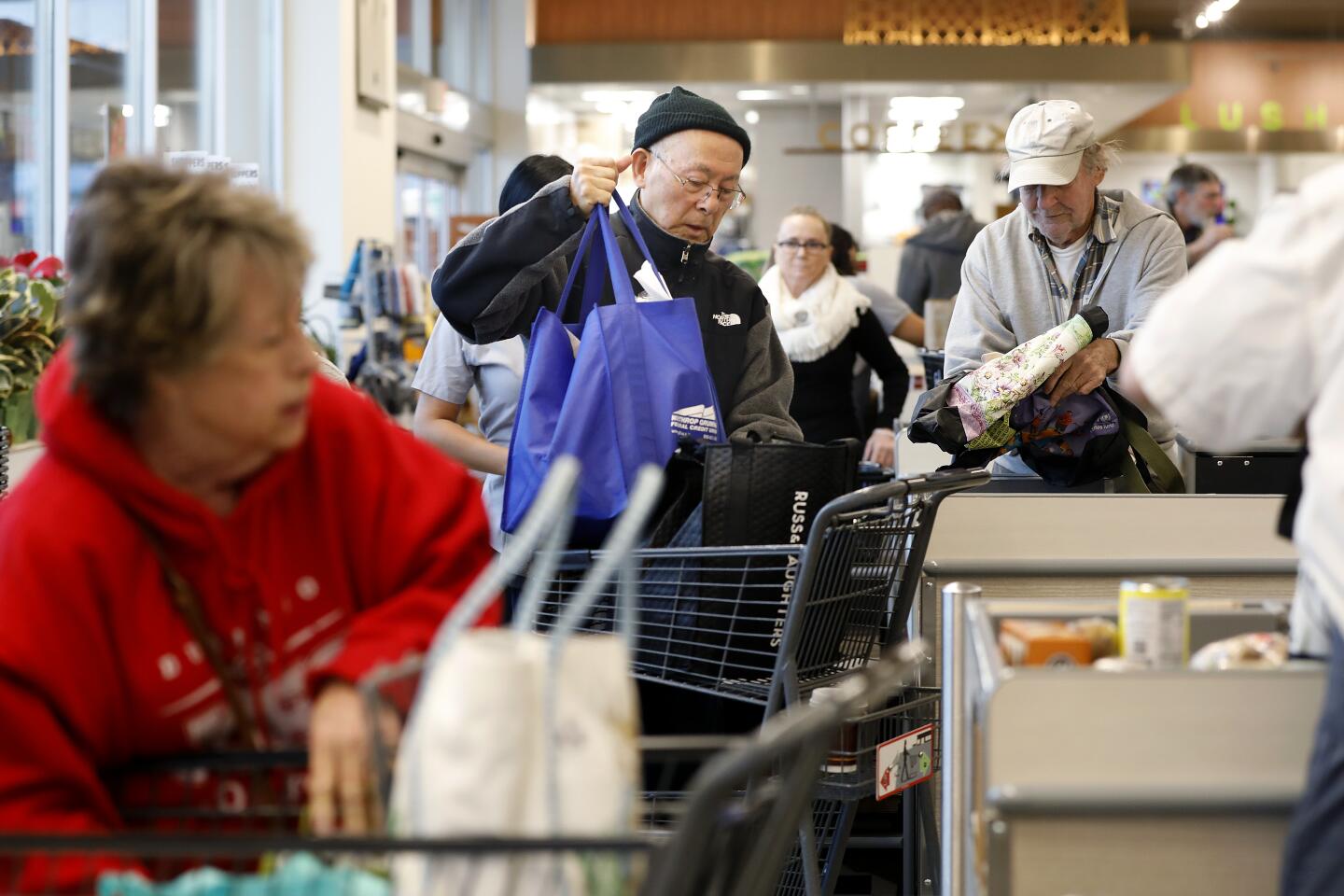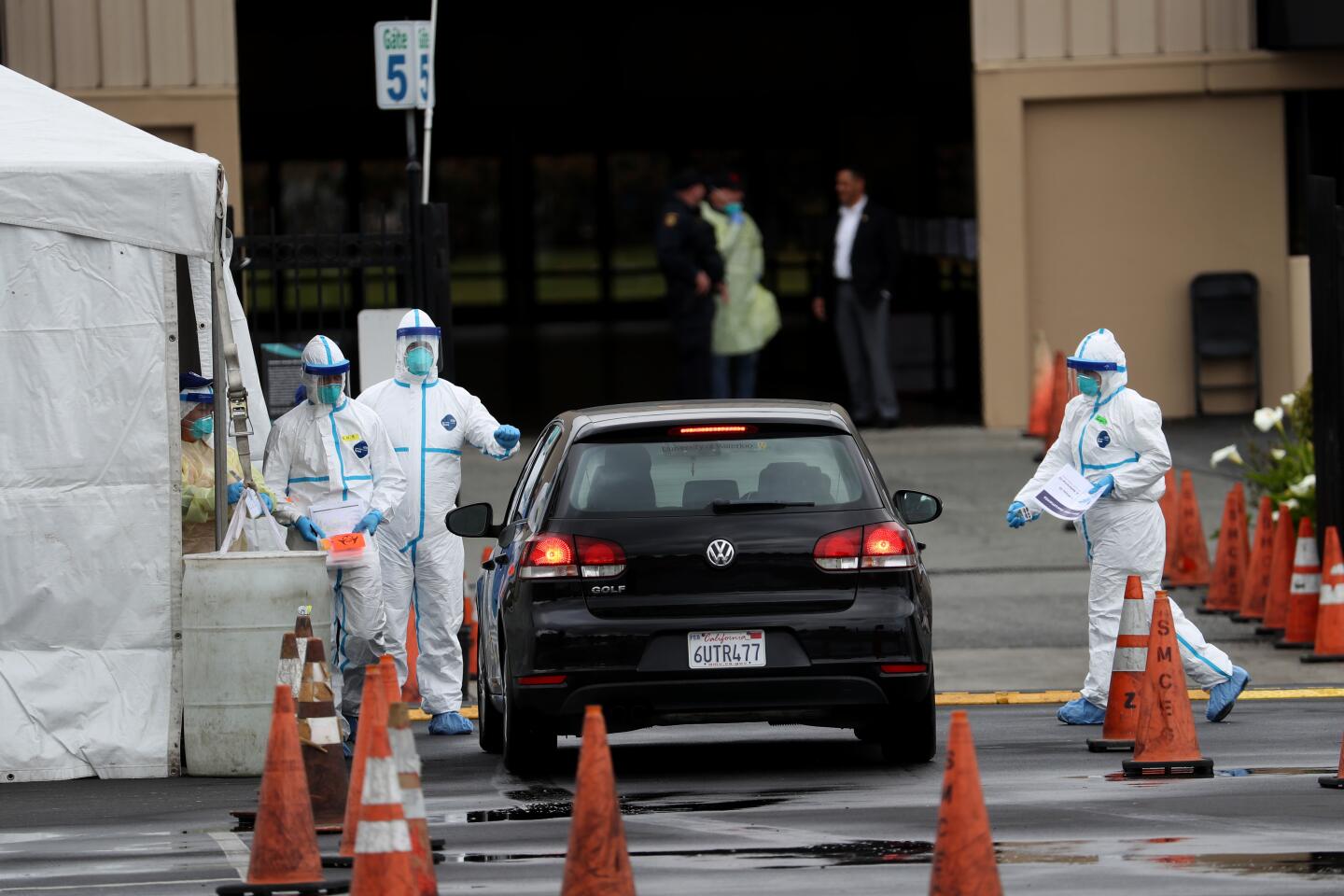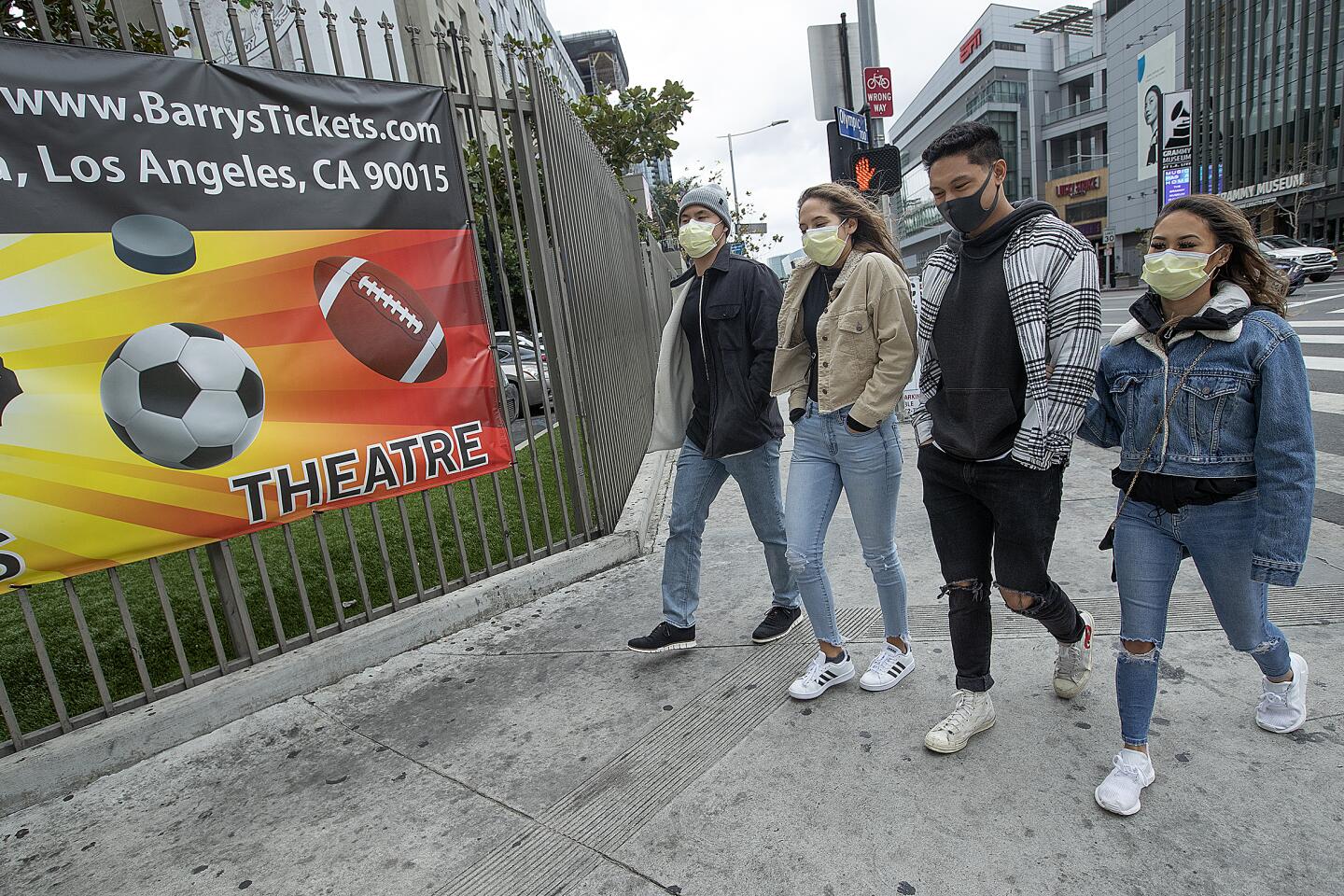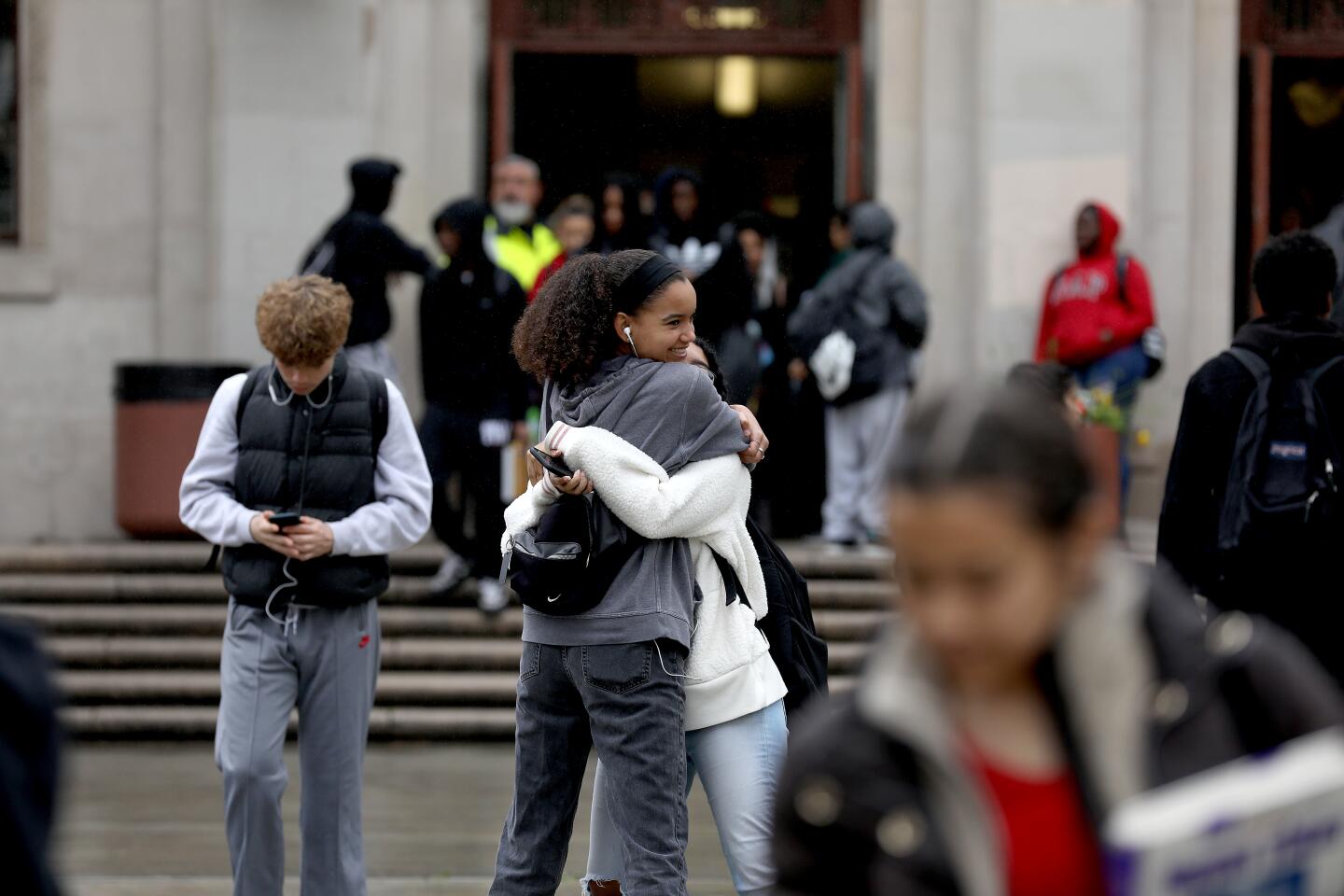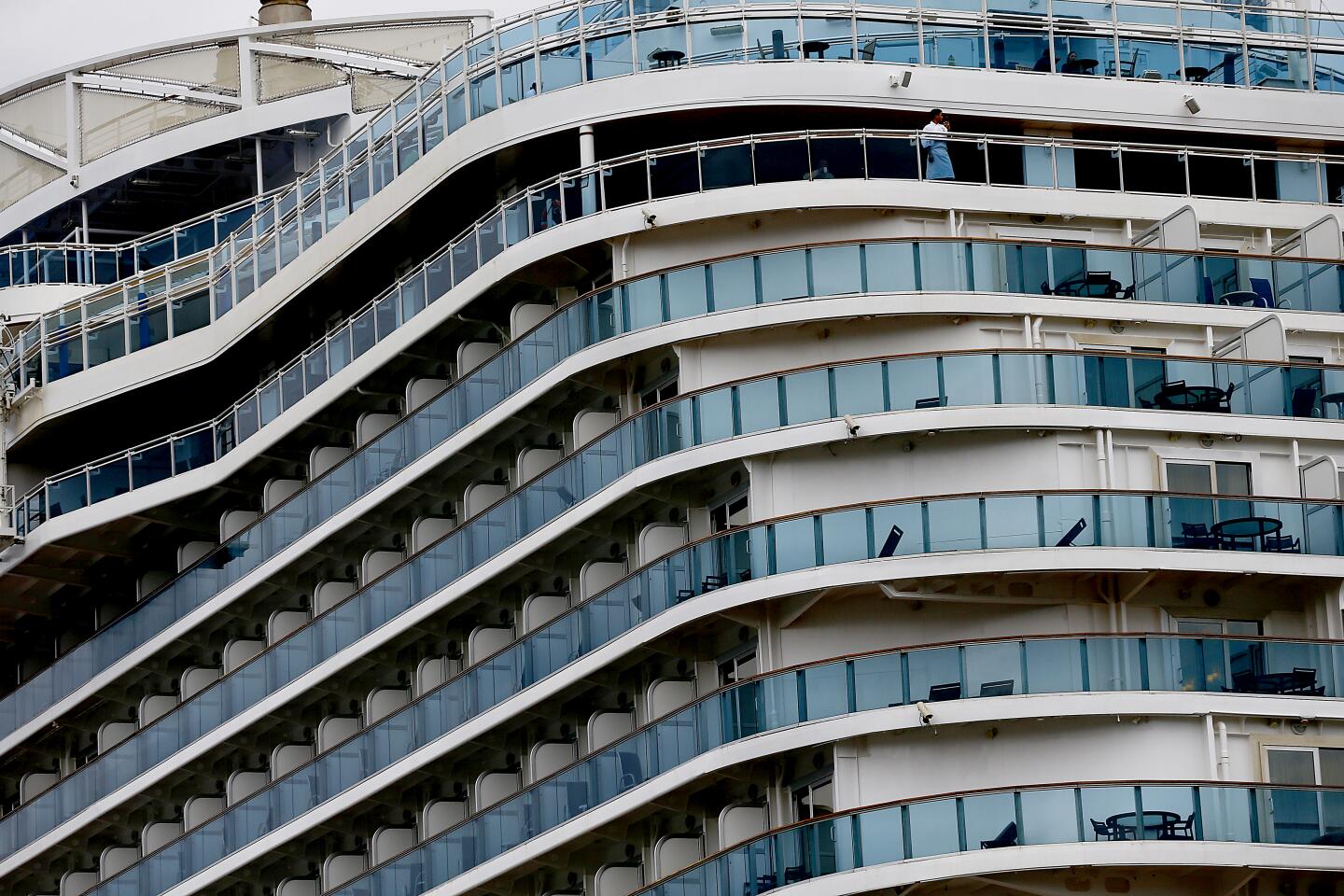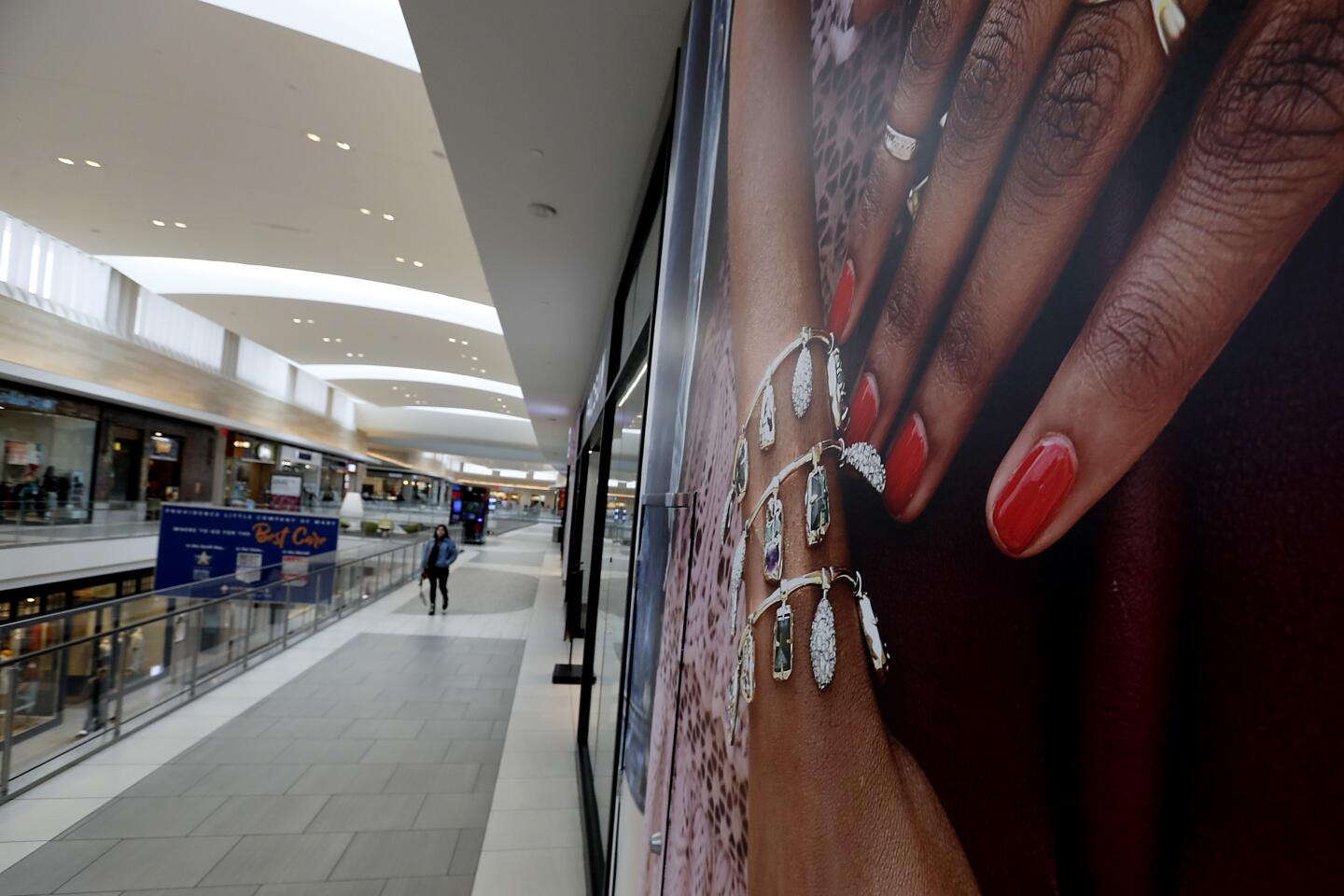L.A. County coronavirus cases hit 40 as community spread intensifies; state reported its fifth death
- Share via
Santa Clara County announced a second death from COVID-19 Friday evening. The person who passed away was an adult woman in her 80s, was hospitalized March 9, and was among the COVID-19 cases previously reported by the county, a news release from the county’s public health department said.
The death was the fifth in California, which had 247 confirmed cases of COVID-19 as of Friday morning. Santa Clara County has the most cases of any county in the state, reporting 79.
L.A. County Public Health Department officials confirmed eight new cases of the novel coronavirus Friday, bringing the local total to 40.
Three of those cases are likely the result of community transmission, as the source of exposure is unknown. Two of the individuals are hospitalized, public health director Dr. Barbara Ferrer said at a news conference.
Children’s Hospital Los Angeles said in a news release Friday that it was treating a child between the ages of 6 and 9 with COVID-19. The child, who had no history of travel and has an unrelated underlying medical condition, was in isolation, as were the child’s parents, the hospital said.
Officials said they expect cases to expand significantly as more people get tested. Ferrer said L.A. County got more test kits this week, and noted that initial testing limitations have made estimates difficult to gather.
“It’s very hard to know how many cases we have,” she said.
On Monday L.A. County officials will release geographic locations and age groups of the known cases. Those who may be close contacts of individuals who test positive for the virus may start receiving “blanket quarantines,” rather than being interviewed first, Ferrer said.
In Riverside County a former patient from a Rancho Mirage skilled nursing home tested positive for COVID-19, officials said Friday. Cameron Kaiser, Riverside County public health officer, said the department plans to test each patient and employee at the 99-bed facility as soon as possible.
“Quick action is required when we are dealing with a vulnerable population like this,” said Kaiser.
An elderly patient at a Northern California assisted-living facility died from the disease earlier this week, and the death toll has mounted at a Seattle-area nursing home that has been at the center of the U.S. coronavirus epidemic.
As the number of cases throughout the world grew to more than 137,000, with more than 2,500 infections reported in Italy, World Health Organization officials said Friday that Europe has now become the epicenter of the COVID-19 pandemic.
“More cases are now being reported every day than were reported in China at the height of its epidemic,” said WHO director-general Tedros Adhanom Ghebreyesus.
In the U.S., President Trump declared a national emergency, freeing up more resources to aid local and state governments. House Speaker Nancy Pelosi and Treasury Secretary Steven T. Mnuchin reached a deal on an economic stimulus package, providing paid sick leave for workers and billions of dollars for food programs and unemployment benefits.
At the same time, school districts, sports organizations, concert promoters and religious groups were racing to cancel or delay large gatherings to guard against the spread of the virus.
The National Collegiate Athletic Assn. canceled its men’s and women’s basketball tournaments, all theaters on Broadway went dark, the U.S. Supreme Court said it would no longer welcome visitors, and Major League Baseball called off spring training games and delayed the start of the season by at least two weeks.
Amid growing concerns and fresh signs that the virus is continuing to sweep across California, officials continued to take action against the virus.
School officials announced that Los Angeles Unified School District – the second largest school district in the U.S. – would shut down on Monday as fears over the coronavirus continued to mount. The move will affect more than 670,000 children and adult students.
LAUSD Superintendent Austin Beutner said that the district was planning for a two-week closure, at least, but refrained from providing a reopening date.
“These next two weeks will be difficult, and we are not certain what lies ahead after that,” he said.
Other school districts across the state continued to close campuses, affecting hundreds of thousands of students. Long Beach Unified School District, San Diego Unified School District, Santa Clara Unified School District, and Oakland Unified School District officials announced that schools would close until at least early April. San Francisco announced it was closing its public schools for three weeks, beginning Monday through the end of the regularly scheduled spring break April 3.
The Archdiocese of Los Angeles also announced that Catholic schools in Los Angeles, Ventura and Santa Barbara Counties would close and move to remote learning effective Tuesday, until at least March 31. The archdiocese serves nearly 75,000 students, including many from low-income and immigrant communities.
“We recognize the significant impact this extended closure will have on our entire community, students, families, and staff,” Paul Escala, Superintendent of Catholic Schools wrote in a letter to families. “We also acknowledge the burden this will place on our staff and working families. As a community of faith, we must come together and help one another.”
Earlier the archdiocese announced it was lifting from its parishioners the obligation of attending Sunday Mass for the next three weeks. The Diocese of San Jose issued a similar suspension on all public masses beginning Saturday.
“Baptisms, weddings, and funerals may be celebrated but should be limited to immediate family,” San Jose diocese Bishop Oscar Cantú said.
L.A. Mayor Eric Garcetti said City Hall would be closed to non-city employees, with the exception of members of the public attending City Council meetings. The Los Angeles City Council also planned to sharply reduce the number of public meetings, to limit potential public exposure to the virus.
With Garcetti’s order properties to limit city properties to no more than 50 outside visitors at a time, the operators of Griffith Observatory opted to close. The Hollywood Hills landmark normally has about 4,000 visitors a day. The Los Angeles Zoo also said it would close.
The city-owned Los Angeles Convention Center is rescheduling the Rug Show, the Best of You LA Expo and about eight other planned consumer shows, said Doane Liu, executive director of the Department of Convention and Tourism Development.
The Los Angeles Public Library said Friday that the Central Library in downtown and all 72 branch libraries will close through March 31. Due dates for borrowed materials are being extended and late fines waived during the closure period, the library said in an announcement on its website.
The Los Angeles County Museum of Art and Natural History Museums announced they will close their main campuses until further notice. The decision affects LACMA’s main Wilshire campus, the museum’s gallery at Charles White Elementary School in MacArthur Park, and all public programs and events.
The Los Angeles County Probation Department, which maintains juvenile halls and camps, is temporarily suspending visitations to its juvenile halls and residential treatment facilities in an attempt to keep the coronavirus from infecting its staff or the youth under their supervision, officials said Friday.
The prohibition applies to weekend, special and after-court visits from family or community groups, but will not stop court-ordered or required legal visits from taking place, according to the department. Youth will have extended phone privileges and internal programming will continue, officials said.
The calls for “social distancing” to slow the spread of the virus that causes COVID-19 could be seen from the San Francisco waterfront, where normally bustling food stands were nearly empty, to Los Angeles International Airport, where cars could make the usually jammed vehicle loop in just five minutes.
In Palm Springs, the landmark aerial tramway closed indefinitely. And following Disneyland’s announced closure through the end of March, Universal Studios theme park said it, too, would close through March 28, while the adjoining Universal CityWalk shopping center would remain open. Six Flags Magic Mountain, Six Flags Discovery Kingdom and Knott’s Berry Farm will all close until the end of March.
Disney said it planned to keep hotels at the resort open until Monday to give guests time to make plans. The company said it would pay its employees during the shutdown.
The park has closed only three other times since its 1955 opening: on a national day of mourning after the 1963 assassination of President Kennedy, following the 1994 Northridge earthquake and after the Sept. 11, 2001, terrorist attack on the U.S.
Santa Clara County, which has been hard hit, banned all gatherings of 100 or more and limited gatherings of 35 or more. No sick individuals or high-risk persons may be present at such gatherings, officials said.
County Health Officer Dr. Sarah Cody called the virus a historic struggle in medical terms.
“These measures are designed to slow the spread of disease,” Cody said.
The number of confirmed cases rose to at least three in San Joaquin County — prompting officials there to declare a local public health emergency — and Santa Cruz County now has at least seven cases.
“We have shifted our efforts away from containment and towards mitigation,” said Santa Cruz County Health Officer Dr. Gail Newel. “We continue to work closely with our regional, state and national partners in our efforts to lessen the impact of COVID-19.”
After calling for the cancellation of all gatherings of more than 250 people, California Gov. Gavin Newsom issued a sweeping executive order allowing the state, if necessary, to take over hotels and medical facilities to treat a potential tide of coronavirus patients.
“This is where we need to go next,” Newsom told reporters Thursday, adding that the shutdowns are aimed at slowing the virus’ spread and to “get through the next few months, so we don’t overwhelm our healthcare delivery system.”
The governor had exempted casinos, card rooms and movie theaters from his guidance against large gatherings. But he said his administration was “moving quickly and effectively towards a resolution” with those businesses. Newsom said that movie theater operators had told him they were trying to devise ways to introduce social distancing while still allowing patrons to gather to see films.
Christopher Thornberg, founding partner of Beacon Economics, compared the situation to a “national earthquake” that is hitting hard but will pass.
“If we just close down the damn country … we might get in front of this and stop it, in which case that short-term panic will lead to a collective sigh of relief,” he said.
Two days after the World Health Organization first said that COVID-19 had caused a world pandemic, health experts struggled to come to grips with the magnitude of the challenge.
At a House Oversight Committee hearing Thursday, Dr. Anthony Fauci said the U.S. was “failing” to provide testing for everyone who needs it.
“The system is not really geared to what we need right now — what you are asking for,” said Fauci, the director of the National Institute of Allergy and Infectious Diseases. “That is a failing…. Let’s admit it … the idea of anybody getting it easily, the way people in other countries are doing it, we’re not set up for that. Do I think we should be? Yes.”
Sen. Dianne Feinstein (D-Calif.) sent a letter to Vice President Mike Pence — who is heading the White House response to the disease — urging the administration to rapidly expand coronavirus testing capacity and to establish clear guidelines for when state and local government should deploy public health measures.
The head of the American College of Emergency Physicians said in a call with reporters that the virus would “put a fairly tremendous strain on our health system.” Dr. William Jaquis said he expects the case counts to rapidly increase in the coming weeks, adding: “COVID is very serious and we’re treating it as such.”
Another federal official said blood banks had seen a substantial drop in donations because of a fear of the coronavirus. That trend needs to be reversed, said Dr. Peter Marks, director of the U.S. Food and Drug Administration’s Center for Biologics Evaluation and Research.
“We need people to prevent the blood supply from getting depleted. We need it not to get to the point that surgeries are having to get canceled,” Marks said. “To ensure an adequate blood supply, we need people to come out and donate blood.”
Even as they scrambled to address the threat, public officials had to tend firefighters and police officers whose work exposed them to the virus.
Los Angeles County Sheriff Alex Villanueva said three deputies and five county Fire Department staff members had been placed under quarantine after responding to a call Monday involving a person in Walnut who later died of the coronavirus.
The department announced that six firefighters were quarantined after responding to a call at Union Station on March 2. The woman had respiratory issues and declined to be transported to the hospitals. LAFD was notified that she tested positive for the virus on Friday. The firefighters had regularly reported to work, but have not shown symptoms. They will only need to be quarantined for three more days.
Times staff writers Hailey Branson-Potts, Andrew J. Campa, James Rainey, Susanne Rust, Dakota Smith, Alex Wigglesworth and Richard Winton contributed to this report.
More to Read
Sign up for Essential California
The most important California stories and recommendations in your inbox every morning.
You may occasionally receive promotional content from the Los Angeles Times.







